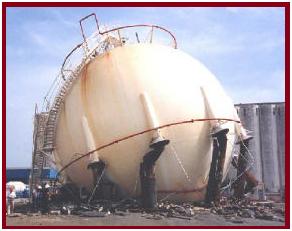|
During hydrotesting and pressure testing operations incidents sometimes happen. This small article provides five typical examples which can be used as an aid in highlighting the hazards and dangers involved are what are often seen as routine operations. - Hydro-test of a new vertical vessel (Fig. 1):

Fig. 1: Explosion of a vertical vessel during hydrotesting
The root cause of the incident is not fully known but there was some thought that hydrotesting with “very cold” water was a contributing factor. Fortunately no injuries occurred. Water temperature is critical when hydro testing. Both metal and water temperature during pressure testing shall be maintained at least at 16°C or at least 10°C above the impact test temperature of the metal. - Filling of a vertical tank (Fig. 2):
The filling of the tank was made with water from a fire hydrant. The top of tank blew off because the relief valve could not displace the air fast enough for the volume of water that was being pumped in. Fortunately no injury happened, but an operator was on top of the tank a few seconds before.

Fig. 2: Top of tank blew off during hydrotesting
Venting systems shall be inspected and checked before filling and emptying operations. - Emptying of a vertical tank (Fig. 3):
The collapse of this tank happened while it was being emptied. A plastic sheet protecting the roof was trapped in the vent; hence a vacuum was caused. So the venting systems shall be inspected and checked before filling and emptying operations. There was no injury. It should be noted that this type of incident is not that unusual.

Fig. 3: Collapse of tank during hydrotesting
- Sphere collapse (Fig. 4):
The accident happened during the filling of a 2000 m3 LPG sphere. Its legs collapsed. One person was killed and one seriously injured. At the time of the accident, the sphere was approximately 80% full of fresh water. The vessels last hydro-test was 10 years ago and the last inspection of its legs was 5 years ago. Severe corrosion of the legs under the concrete fire protection was the main cause. The corrosion occurred due to water ingress between the concrete and the steel legs. The water protective cap located over the concrete was not sufficient to keep the water out. After the accident, it was verified that the steel legs had thickness reductions of up to 8mm, with pitting holes of up to 10cm2.

Fig. 4: Sphere Collapsed during hydrotesting
After analysis and tests, it has been found that the following factors caused the collapse: - Water caps over the fire-proofing concrete were of poor design thereby letting water penetrate between the steel beams and the concrete.
- Vertical cracks in the concrete let water in.
- Repairs had been done to the concrete, but with poor workmanship.
- The new concrete had not adhered to the old concrete, again letting water in.
- The deluge system had been tested with salt water, increasing the possibility of corrosion.
Before testing an old vessel, a complete inspection must be performed visually and with NDT. This inspection shall include the vessel, nozzles, appurtenances, and supporting structures. - Emptying of a gear box (Fig. 5):
To speed up the removal of 250l of oil from a gear-box, the gauge hole was plugged and the breather was connected to the 6 bar air network. The gear box exploded, and threw missiles around seriously damaging surrounding piping and structure. Fortunately there was no injury.

Fig. 5: Gear box explosion
Obviously a gear-box is not a pressure vessel, but productivity may lead to a risky attitude RECOMMENDED ACTIONS FOR PRESSURE TESTING: Tests may be a routine operation pressure but do not forget that in fact pressurisation is energy storage. Its instantaneous release works as a bomb and may cause severe damage to persons and equipment.
As for most of the operations, good preparation is essential to avoid incidents. It is recommended to use the following check list: - A detailed check list procedure must be prepared as per the standards and specifications. It must cover the testing operation from filling up to emptying the vessel.
- Good co-ordination is essential to avoid performing the hydro-test at the same time as other operations. A work permit procedure / Job Hazard Analysis should be used,
- The equipment should be in good condition and adequately maintained and certified,
- Testing equipment must be as far as practicable from the recording and pumping station,
- Testing equipment (even if brand new) must be checked.
- The test area must be roped off,
- During the test, from filling up until the end of depressurisation, all non-essential people must be out of the test area,
- The test crew must attend a toolbox talk,
- All people must wear their appropriate PPE,
- Inspection for leaks shall be performed at least 15mn after the test pressure has been
- reached and only by designated personnel,
- Never tamper with, or tighten any fittings (i.e. connections, bolts, hoses and the like) while under pressure or during pressure-up stages.
| 